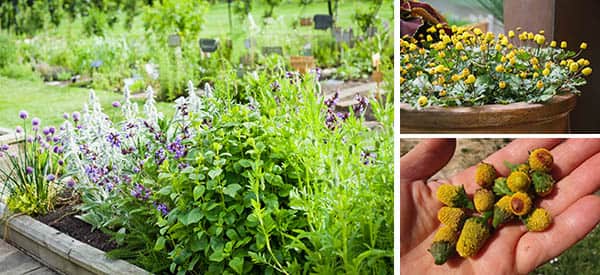
The Toothache Plant That Every Herbalist Should Grow
You may know Spilanthes by one of its many (very descriptive!) names: jambu, electric daisy, buzz or Szechuan buttons, toothache plant, paracress, or eyeball plant. But regardless of what people call it, the toothache plant (Acmella oleracea) has some incredible healing properties and is a beautiful and unique plant.
It’s a must-grow in any herbalist’s garden, both for its medicinal benefits and striking flowers. Spilanthes, or toothache plant, can numb a sore mouth when you chew it. It can also reduce inflammation in the mouth, helping soothe a condition called stomatitis. Because of its anti-inflammatory properties, it can also help improve symptoms of dermatitis and help during cold and flu season. Have a dry mouth? The people of Sri Lanka have been using spilanthes to stimulate the salivary glands for thousands of years. Clearly, it’s an important plant to have on hand!
You’ll know spilanthes when you see one, because of their distinctive red and yellow blooms. It gets one of its many names, the eyeball plant, from the shape of its flowers. They are small and pom-pom shaped, with a wide yellow outer rim and a red center. Look closely—the blooms are actually made up of hundreds of tightly packed flowers. The leaves of the toothache plant are green with ruffled brown edges that grow on long stems.
Why and How to Grow “The Toothache” Plant
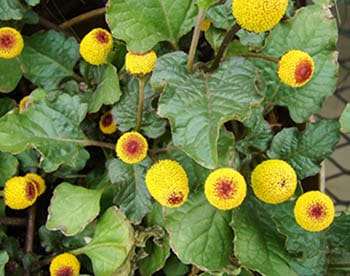 Growing spilanthes is relatively straightforward, as it does well in a wide variety of climates (USDA Zones 9-11) and can be planted in containers or garden beds. It’s a member of the Asteraceae family, which also includes asters, daisies, and cornflowers, so it fits right in as a beautiful complement to the rest of your garden with blooms that are consistent from mid-June through September. You can find seeds online or in local nurseries that specialize in tropical plants. Once your plants start blooming, you’ll see that they are resistant to disease, grow quickly, and attract bees, butterflies, and songbirds!
Growing spilanthes is relatively straightforward, as it does well in a wide variety of climates (USDA Zones 9-11) and can be planted in containers or garden beds. It’s a member of the Asteraceae family, which also includes asters, daisies, and cornflowers, so it fits right in as a beautiful complement to the rest of your garden with blooms that are consistent from mid-June through September. You can find seeds online or in local nurseries that specialize in tropical plants. Once your plants start blooming, you’ll see that they are resistant to disease, grow quickly, and attract bees, butterflies, and songbirds!
To grow spilanthes from seed, take the following steps:
- Start seeds indoors 4-6 weeks before your region’s last frost.
- Prepare your seed trays with high-quality seed-starting soil.
- Press the seeds into the soil without covering the seed, as the seed needs light to germinate.
- Water your seeds lightly, keeping the soil consistently moist but never wet or thoroughly soaked. Toothache plants don’t like boggy, swampy soil.
Once all threat of frost passes and the weather warms to daytime temperatures of 65℉, transition your seeds into either containers or garden beds, in a location that gets full sun with well-draining soil.
If growing multiple plants in a bed, make sure you space your plants at least one foot apart, as they like to spread!
Once you’ve planted your toothache plant, regularly deadhead blooms that have gone to seed to encourage new growth.
You can also directly sow spilanthes seeds into your garden, but make sure you’ve waited until the weather has warmed up and all threat of frost has passed. When sowing seeds directly into the ground, plant two or three seeds every six to twelve inches by lightly pressing them into the soil (don’t fully cover them!). Once plants have sprouted, thin the new shoots down to one plant every twelve inches so the mature plant has a chance to grow.
Harvest your spilanthes once the stems have grown at least four to six inches in height, usually about six to eight weeks after germination. It’s possible to cut leaves off the plant before then, but you might hurt your plant’s overall growth if you take off too much before it has a chance to establish a root system. Both the leaves of the spilanthes and the blooms are useful, making the toothache plant an invaluable part of your garden.
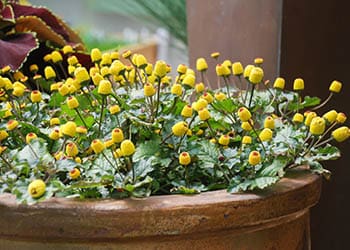
Your plants will be most effective if you wait to harvest them until they are at the peak of their flowering cycle. Cut blooms just below the neck of the flower when the blooms have begun to elongate and become more cone-like, but before the red center has grown out and disappeared completely. If the red center of the flower is gone and the flower is more of a long cone than a round button shape, the flower has gone to seed and won’t be as effective.
You can cut the leaves any time after the plant has reached about half its overall height. Siplanthes is very distinctive, but while harvesting, make sure you don’t confuse it with globe chamomile (Oncosiphon pilulifer) or billy buttons (Craspedia canens), both of which have yellow, ball-like flowers. You can tell the difference by the center of the flowers: neither globe chamomile or billy buttons have red centers like the toothache plant.
Once harvested, you can either use Spilanthes fresh, or dry the flowers and leaves for use in tinctures and teas later. To dry your plant, arrange the flowers and leaves in a single layer on a screen or in a basket. Place in a cool, dry location, and check every few days to make sure the moisture is leaving the plant. Generally, spilanthes will dry in less than a week and you can store it in your method of choosing: either plastic bags, dry bags, or glass containers.
What is The Toothache Plant Good For
Spilanthes is remarkably versatile and is used to help soothe a variety of ailments. For example, you can use spilanthes to:
- Treat dry mouth: cut a fresh leaf off the plant and chew vigorously to help activate your salivary glands.
- Treat a sore mouth, including toothaches, canker sores, or stomatitis: both the leaves and the blooms are effective, but chewing the blooms especially will make your mouth tingle and feel numb. The plant also has antifungal and antiviral properties to help your mouth heal and can be taken in a tincture.
 Act as a diuretic: chewing the leaves or blooms fresh or drinking them in tea can help increase kidney function.
Act as a diuretic: chewing the leaves or blooms fresh or drinking them in tea can help increase kidney function.- Treat dermatitis: drink spilanthes tea or take a tincture regularly to help treat sore, itchy, or inflamed skin.
- Boost the immune system: in teas and tinctures, spilanthes can help bolster your immune system and soothe inflammation throughout the body, especially in winter during cold and flu season.
Related: Similar to Morphine: The Best Natural Painkiller that Grows in Your Backyard (Video)
Though spilanthes might help with many ailments, it may be necessary for you to avoid it if you have an existing allergy to the Asteraceae family, you are pregnant, you drink alcohol (it can slow down the metabolism of alcohol), or you already take diuretic medicine.
The Toothache Plant in the Kitchen
Don’t discount spilanthes in the kitchen! Small amounts of spilanthe’s leaves can be chopped up fresh and added to fresh greens, like spinach. You can also add the flowers sparingly into salads, or, if they’re dried, added on top of a cocktail as an edible garnish. With its slightly grassy, citrus-tinged taste and unique buzz in the mouth, it’s a fun and surprising addition to salads or other vegetable-based dishes. You can also toss the fresh or dried leaves into stews and soups for an added kick. Add the dried blooms and flowers to your regular rotation of teas in the winter to help bolster your immune system and keep your immune system in check!
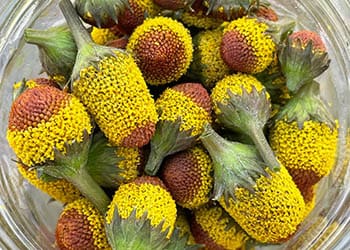
To make a tincture with spilanthes, pack a glass jar with one part fresh toothache plant blooms and leaves to two parts alcohol (100 proof). Roughly chop the spilanthes in the jar, then cover it with alcohol. Store in a cool, dark place, and shake the jar once a day for four to six weeks. After no more than six weeks, strain the liquid into a brown glass dropper vial (use for no more than a year).
You can add one to two drops of spilanthes tinctures into a spoonful of honey or add it to teas for its medicinal benefits. If you have a sore mouth or toothache, you can also put a few drops in warm salt water and swish it around your mouth for its antifungal properties!
There is no end to the ways that spilanthes can improve your garden and your health. It’s a remarkable plant and a gorgeous flower that no herbalist’s garden is complete without!
You may also like:
How To Reduce Dental Pain Naturally
I Stopped Spending Money At The Pharmacy By Growing These 10 Plants (Video)
Home Remedies to Whiten Your Teeth Naturally

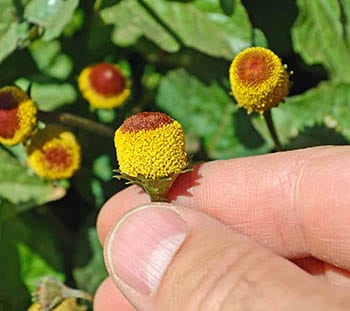 Act as a diuretic: chewing the leaves or blooms fresh or drinking them in tea can help increase kidney function.
Act as a diuretic: chewing the leaves or blooms fresh or drinking them in tea can help increase kidney function.
Love your emails
Hello Gina,
Thank you for your comment! It’s so nice to hear that our readers enjoy the newsletter.
Many blessings and good health!
In the article, you say it can grow in a “wide-variety” of climates, but specify, zones 9-11. That hardly seems wide, especially to us northerners.
I live in zone 5, and 1 grew one a few years ago that got large and beautiful.